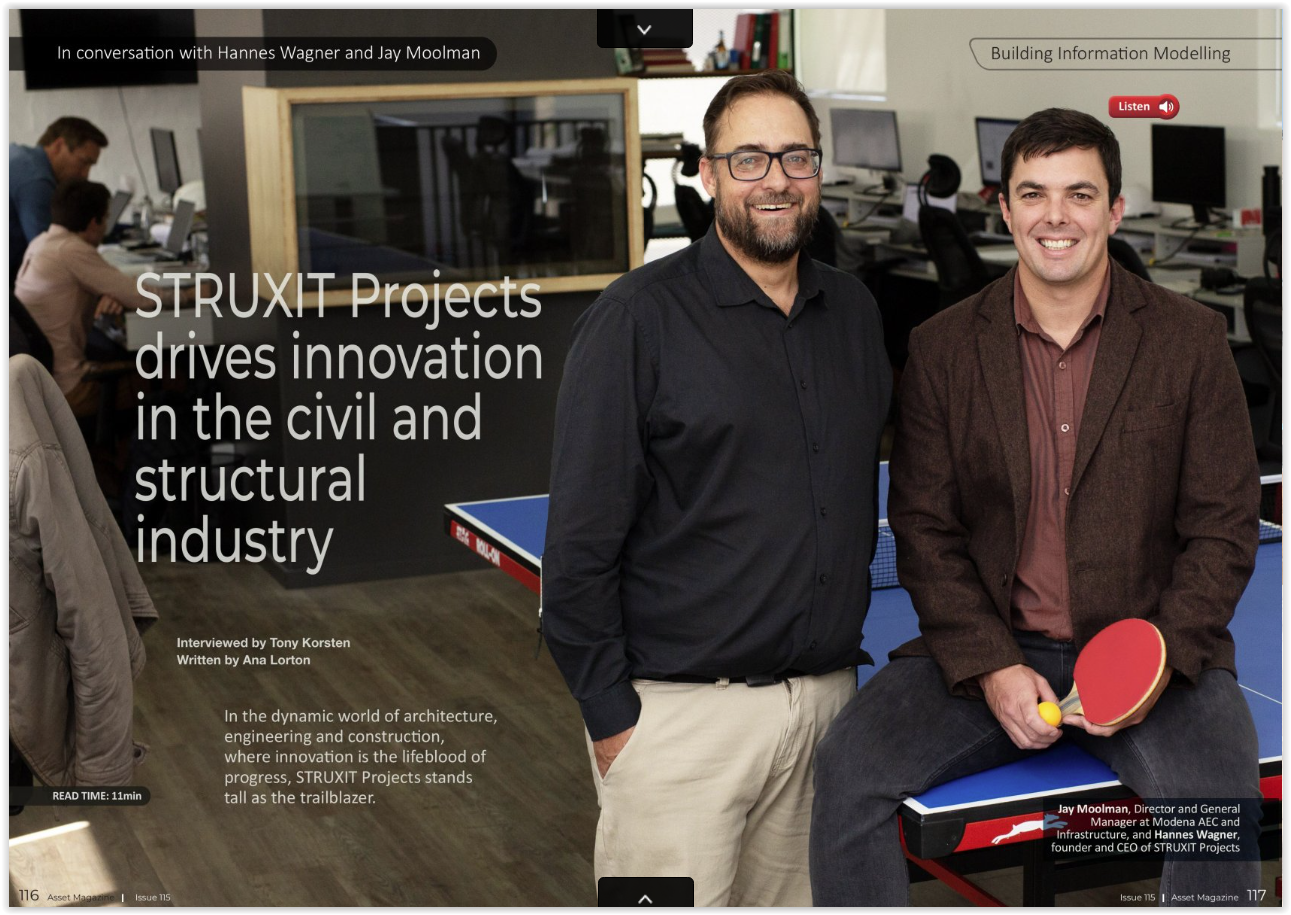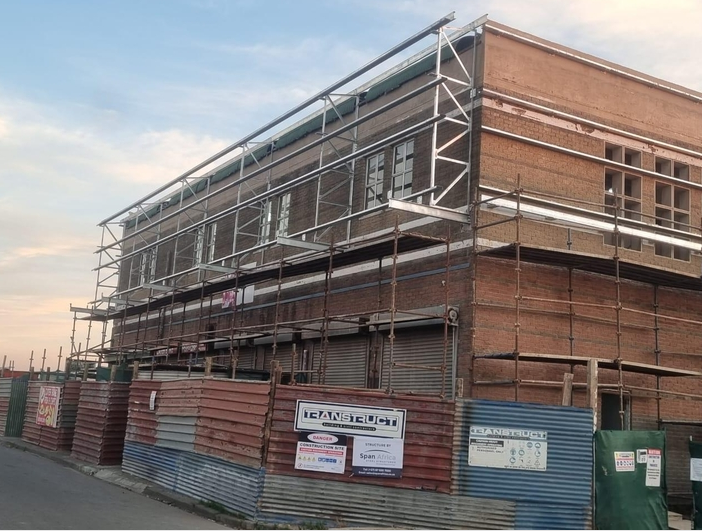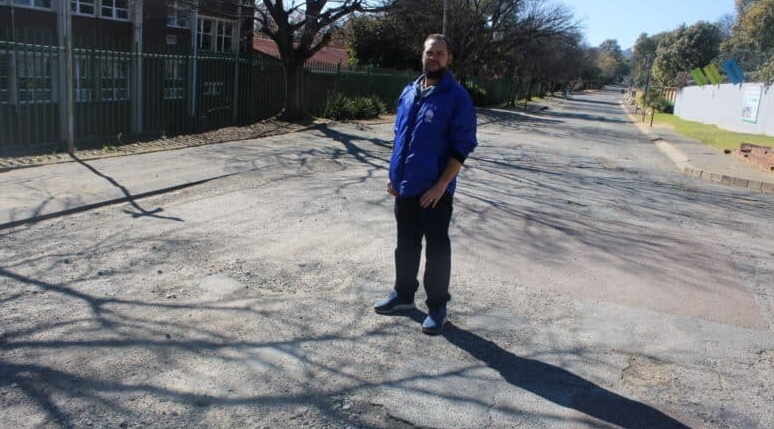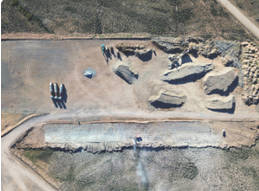STRUXIT Projects drives innovation in the civil and structural industry

Advertising
21-06-2023
Read : 349 times
L2B
Source
STRUXIT Projects drives innovation in the civil and structural industry
In the dynamic world of architecture, engineering and construction, where innovation is the lifeblood of progress, STRUXIT Projects stands tall as the trailblazer.
Asset recently acted as the conduit for a stimulating exchange of insights between Hannes Wagner, founder and CEO of STRUXIT Projects, and Jay Moolman, Director and General Manager at Modena AEC and Infrastructure. STRUXIT is a full-service civil, structural and façade engineering company headquartered in Gauteng, while Modena represents the only Autodesk Platinum Partner in Africa. The synergy between the two entities has its roots in STRUXIT’s forward-thinking approach to the use of technology. As a longstanding client of Modena, it continues to demonstrate an outstanding ability to utilise tech resources innovatively and well.
“Hannes has been our client for a number of years,” Jay comments, “And we’ve observed with admiration what STRUXIT has been able to achieve using just one tech resource, for example, while another company would require two or three resources to reach the same endpoint. The way in which Hannes and his team of engineers have embraced Autodesk Revit software built for Business Information Modelling (BIM) to realise better ways of working and better outcomes for their clients, lies at the core of their growing success.”
Game-changing technology
Modena’s software and the training and support it provides users has been both a revelation and a game-changer for STRUXIT. Hannes founded the company in 2013 but had been keenly aware of the power of BIM and Autodesk more than ten years ago while employed at a multi-national engineering firm. He clearly remembers a presentation by the head of their EMEA division predicting that by 2025 technology would have made specific jobs within the construction industry obsolete. While the pace of this prediction is not yet that rapid in South Africa, Hannes has observed its influence within STRUXIT.
“We can definitely see the impact of some of the technology we are using with the support of Modena,” he says. “It has, in effect, provided us with an additional ‘team member’ in terms of what we can do. Efficiency is one of the biggest outcomes, and for us as a service delivery company, efficiency is how you measure unit profit at the end of the day. There is no doubt that the use of BIM is positively impacting profit margin. For us it's proving a clear driver of net profit. We’re seeing this at first-hand.”
Support on tap
Having previously made use of Modena’s support on an hourly basis to help develop customised business solutions, STRUXIT has now taken the step of having a Modena team member based in its office three to four days a week. While there is a cost-implication, Hannes points out that the resultant increase in efficiency and business coming in, effectively means that STRUXIT has added two additional ‘team members’ to its team. The more it can add by virtue of its technology capabilities, the more the company’s bottom-line grows.
“We offer upskilling and training on our products,” says Jay,” but as we’re seeing in our partnership with STRUXIT, we have the ability to offer high-level customized workflow-based implementation consulting. For example, with STRUXIT we’re looking at ways we can automate certain features using the software to further streamline processes. We can create a comprehensive package of solutions, not just automation around one element. It's very much about how you use the software, not necessarily whether or not you can use the software.”
Unique solutions
While there is plenty of literature available online in terms of Autodesk products’ basic and advanced level usage, Hannes’ directive to Modena was to do a considered analysis of tech solutions not freely available in the public space. He briefed them to devise ways of dealing with problems and repetitive processes specific to the work of a civil and structural engineering practice.
An example which soon came to mind was drawing registers, the controlled list of drawings on a project that provides a standardised way of tracking the addition of revisions and changes to an existing document.
“BIM couldn’t produce them,” Hannes explains, “and because some contractors don't use BIM, these registers need to be physically issued every week or every second week to make sure that all teams on site are working off the latest set of engineering drawings. This meant downloading and exporting workflow which was already on Autodesk to pdfs, and uploading these onto another software platform. With the assistance of Modena, we wrote a plug-in which enables us to take the workflow data directly from BIM 360 – which is an Autodesk cloud-based solution that allows project teams to effectively work in a collaborative environment - and directly generate a drawing register.”
The streamlined approach effectively reduced the number of steps involved in creating a register from five steps to one. Apart from saving time, the one-step method also reduces the risk of mistakes creeping into the registers. “There’s always the risk that the more tasks you repeat, the more mistakes one can make,” Hannes notes. “The tech method we’ve developed to prevent this from happening is a proactive innovation which will be of benefit to others in the industry too, and we’re willing to share it with them.”
Training. Training. And more training.
“Once we’ve created solutions like these,” Jay adds, “we need to ensure that all the relevant people are fully trained and up-to-speed with the technology. Hannes fully backs this. He is always extremely keen to ensure that STRUXIT’s team members are as comprehensively trained as possible, which is not always the case. We sometimes experience companies holding back on investing in staff training in case staff leave. Hannes has a different and refreshing view.”
“We need to ensure that the entire STRUXIT team is operational on the same technical level within their area of specialisation,” says Hannes. “Internal training workshops are documented and uploaded onto a central platform. From there specific course are assigned to team members so that they can upskill themselves. However, we also need to be alert to the fact that although our engineers are fully conversant with the software, not all professionals and contractors we may have to work with are, and this can create pitfalls for us.”
Buy-in is needed for advancement
Both Hannes and Jay agree that as technology advances, management buy-in across the construction industry is essential and may require a massive shift in the way work is traditionally managed. An architectural practice which STRUXIT works with in Durban presents a textbook case of how BIM should be integrated into a project, according to Hannes.
“Their stringent BIM protocol set us up for success. If an entire project is going to be handled on BIM with Autodesk, then we have to follow this protocol very stringently. In a case like this, the project is generally very successful. In other instances we work with contractors who say they know how to use BIM, but they don’t, and this invariably creates problems for us. The impact of this can be very serious. All parties need to know exactly the scope of their responsibilities on a project. We cannot just be told that a BIM model has been published but no changes are indicated on it and it communicates nothing to us. This creates a huge risk for everyone involved, including the client.”
Jay concurs that BIM execution plans on projects are critical and need to be put together with great care and accuracy. Companies need “to slow down to speed up”, as he describes it. Time and expertise must be invested in the planning component to ensure successful use of BIM and remove as many risk elements as possible from the project process.
A treasure trove for FM
By the time a project is successfully concluded with BIM, the software encompasses a huge repository of information and documentation which is available to the developer for use in the ongoing servicing and maintenance of the building. If properly utilised by the Facilities Management team, the value of the asset is ensured well into the future.
“It’s also a real timesaver having information on this scale at hand,” Hannes says. “We’re very aware of this when we’re tasked to do property inspections. The law stipulates that property owners have to inspect their buildings for safety every year, and this must be done by a competent entity. When we visit a site, we already know the typical issues that can arise in a specific type of building. With the BIM plans at hand, we can do a time-efficient and thorough check which is of huge value to the developer.”
Another advantage of using BIM in maintaining a building going forward is that it does away with the ‘silos’ that typically are present in property management. The lines of communication between project teams and the operations division are often poor. “While a developer may want to drive costs down upfront of a development to get the ROI they’ve calculated for the project, they often lose that when they have to manage the property because of a lack of necessary data. BIM breaks down silos internally within the company and also externally with the professional project team when it comes to extending the lifecycle of an asset,” Jay adds.
The key to efficiency, safety and sustainability
STRUXIT’s vision for the future of the civil and the structural engineering industry in South Africa is focused on driving positive change, with a strong focus on the benefit of new technologies. Hannes and Jay believe that these, together with upskilling and ongoing customised tech solutions, are the key to increased efficiency, safety and sustainability.
“At STRUXIT we’ve adopted a holistic view which encompasses our people, the processes we follow and technology. We have an incredible team and their dedication towards bringing these elements together has underpinned our exceptional growth. We want engineers to view technology as an advancement of their skills, not a burden. The faster they buy into upskilling themselves and utilising the software to its full potential, the more efficient they will become, and the more efficient companies will become. This has positive implications across projects, across our client base and across the industry as a whole in SA,” Hannes concludes.
Recent News
Here are recent news articles from the Building and Construction Industry.
Have you signed up for your free copy yet?









